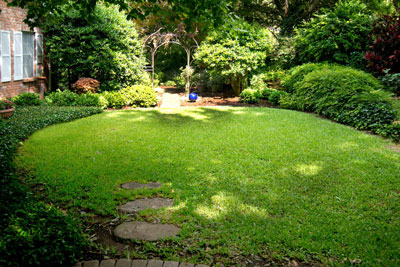Growing Grass Beneath Trees
See if these questions sound similar:
“What’s the best grass to grow beneath my shade trees?”
“What can I add to help grass grow beneath my shade trees?”
“I’ve read that this new grass will grow beneath shade trees. Is it all it’s cracked up to be?”
Do you hear a common thread to those conversations?
Shade trees are valuable commodities in hot Texas summers, but all that shade can spell the end to parts of your lawn. Each type of grass has its own threshold of sunlight requirements, and if it consistently fails to receive those minimum hours it will gradually thin our and die.

Photo: As grass starts to thin, you know shade is becoming excessive. This was the lawn east of our house several years ago.
Frank observations…
I’ve been in this business for 47 years post-college. Both of my degrees were in horticulture, and I worked for Texas A&M (Extension Service) the first seven of those years. Here’s what I’ve seen, and I’m going to be brutally honest.
• There are people who refuse to believe that excessive shade is causing their problem. “But Neil, I know there’s enough sunlight there.” They’ll stand toe-to-toe with me and argue their case, but when I see photos or go to their homes, it’s as dark as a cave back under those trees. I try to be polite as I listen to them, but folks, this is a topic with which I’m completely familiar. In fact, I’ve lived it first hand. We live in a pecan forest, and I’ve made the same mistakes I’m describing.

Photo: Bare ground became more and more distinct as the grass just gave up.
• Folks don’t realize that trees grow larger each year, so shade patterns become more and more dense in toward the trees’ trunks. Think of the tree as a target and the trunk as the bull’s eye. If the thinning grass is worst near the trunk, shade is the reason.
• Gardeners want to believe that some “miracle” grass that’s being touted on television or on social media will solve all their problems. They read testimonials, but they forget to look for local research. These ad campaigns are almost always come-ons.
What can you do?
Here are the steps to coping with shade when your grass starts to fail.
• Determine if any of the trees or lower branches can be removed so that more light can reach the turfgrass below.
• Try St. Augustine. It’s our most shade-tolerant turfgrass for Texas. Fescue is an option in North and Northwest Texas. It’s winter-hardy in areas where St. Augustine isn’t, but it also requires a great deal of water in hot summer weather.
• If you’ve given one of those grasses a chance, and if it started to fade out within a month or two after planting, shade was (and still is) your problem. There’s no point in spending hundreds or thousands more dollars buying and planting more sod.
• Switch to a shade-tolerant groundcover and shrubs to go with it. We have many fine options for Texas gardens, and that’s where we’ll pick up this discussion next week. This is all more than one e-gardens can hold.

Photo: After this area was able to sustain less and less grass, and once I decided to prune no more branches from our large pecans overhead, this grass thinned and died away quickly. I’ll show you how I converted it in next week’s e-gardens.
